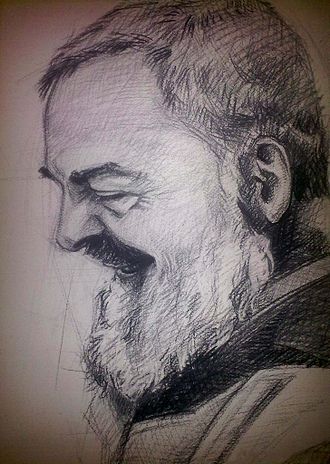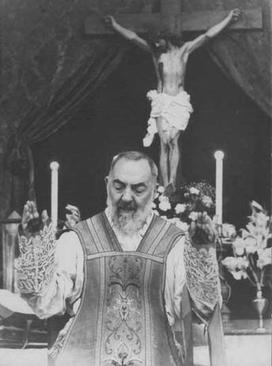My real mission will begin after my death - Saint Padre Pio
 A strong believer in Christian meditation, Padre Pio stated: "Through the study of books one seeks God; by meditation one finds him."
A strong believer in Christian meditation, Padre Pio stated: "Through the study of books one seeks God; by meditation one finds him."
Saint Padre Pio (May 25, 1887 – September 23, 1968) was a Capuchin priest, stigmatist and mystic, venerated as a saint of the Catholic church. Padre Pio became famous for exhibiting stigmata for most of his life, thereby generating much interest and controversy.
On September 20, 1918, while hearing confessions, Padre Pio had his first occurrence of the stigmata: bodily marks, pain, and bleeding in locations corresponding to the crucifixion wounds of Jesus Christ. This phenomenon continued for fifty years, until the end of his life. The blood flowing from the stigmata purportedly smelled of perfume or flowers, a phenomenon mentioned in stories of the lives of several saints and often referred to as the odour of sanctity. Though Padre Pio said he would have preferred to suffer in secret, by early 1919, news about the stigmatic friar began to spread in the secular world. Padre Pio’s wounds are said to have been examined by many people, including physicians.
People who had started rebuilding their lives after World War I, began to see in Padre Pio a symbol of hope. Those close to him attest that he began to manifest several spiritual gifts, including the gifts of healing, bilocation, levitation, prophecy, miracles, extraordinary abstinence from both sleep and nourishment, the ability to read hearts, the gift of tongues, etc. Padre Pio became a very well-known priest.
 Padre Pio celebrating mass. His Mass would often last hours, as the mystic received visions and experienced sufferings.
Padre Pio celebrating mass. His Mass would often last hours, as the mystic received visions and experienced sufferings.
The local bishop, did not believe Padre Pio’s alleged miracles, suggesting that his Capuchin brothers were making a display out of the monk to gain financial advantage. When Pius XI became pope in 1922, the Vatican became extremely doubtful. Padre Pio was subject to numerous investigations. Fearing these local riots, the Vatican dropped a plan to transfer Padre Pio to another friary, and a second plan for removal was also changed. From 1921 to 1922 he was prevented from publicly performing his priestly duties, such as hearing confessions and saying Mass. From 1924 to 1931, the Holy See made statements denying that the events in Padre Pio's life were due to any divine cause.
By 1933, the tide began to turn, with Pope Pius XI ordering the Holy See to reverse its ban on Padre Pio’s public celebration of Mass. The pope said, "I have not been badly disposed toward Padre Pio, but I have been badly informed." In 1934, the friar was again allowed to hear confessions. He was also given honorary permission to preach despite never having taken the exam for the preaching license. Pope Pius XII, who assumed the papacy in 1939, encouraged devotees to visit Padre Pio.
Pope Paul VI (pope from 1963 to 1978), in the mid-1960s dismissed all accusations against Padre Pio. Pope John Paul II (pope from 1978 to 2005) started the canonization process of Padre Pio and canonized him in 2002.
Death & Sainthood
Padre Pio died in 1968 at the age of 81. His Requiem Mass was attended by over 100,000 people. He had often said, "After my death I will do more. My real mission will begin after my death." The accounts of those who stayed with Padre Pio till the end state that the stigmata had completely disappeared without a scar. Only a red mark "as if drawn by a red pencil" remained on his side but it disappeared.